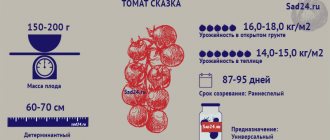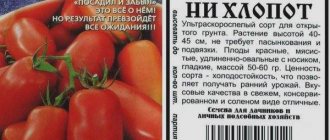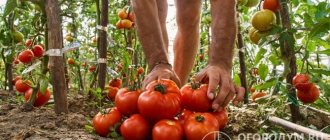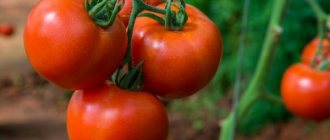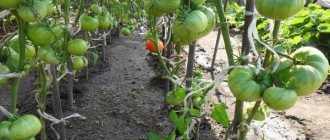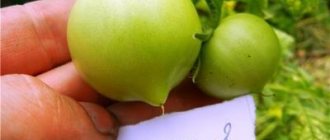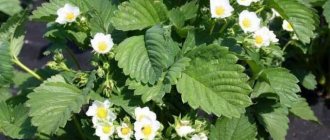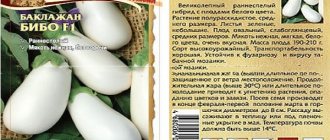Description of tomato variety Sugar Nastasya with photo
Sugar Nastasya tomatoes are an indeterminate (medium-sized) beef variety. In greenhouse conditions they grow up to 1.7 m. When grown in the ground they reach one and a half meters in height. The stems are covered with medium-sized dark-colored foliage, the inflorescences are simple.
Ripens approximately 110-130 days from germination, therefore it is considered medium-late. According to the method of cultivation, it is universal, i.e. it grows both in greenhouse conditions and in the ground, but preference is given to the first option.
Sugar Nastasya tomato bushes can produce large fruits
Description of fruits
A cluster of Sugar Nastasya tomatoes is formed from approximately 8-9 fruits. Heart-shaped tomatoes of raspberry color, closer to red, reach 400 g of weight, i.e. the size of an individual specimen is so large that it barely fits in the hand of an adult.
Attention! To obtain large fruits, the plant is formed into 1 stem, followed by normalization of the ovaries and brushes.
However, the average tomato weighs approximately 200-300 g, which depends on the care of the plant, including the formation of the bush.
The taste corresponds to the name - sweet. However, often the first growing experience turns out to be sour, but if you take their seeds, the subsequent harvest promises to be sweet. The fleshy, dense pulp of the Sugar Nastasya tomato contains many seeds.
How to grow seedlings
Seeds for seedlings are sown at the beginning of March or at the end of February, 2 months before planting in the ground. Overgrown seedlings do not take root well when transplanted to a permanent location.
Seed preparation
Since the crop is not a hybrid, you can prepare seeds for planting yourself, selecting them from the largest fruits. However, such seed requires careful disinfection.
First, the grains are inspected for visible damage, and then they are checked for filling inside. To do this, the seeds are kept for 10 minutes in a saline solution (1 teaspoon of salt per glass of warm water). Those that float to the surface are unsuitable for landing, since they are empty inside.
Disinfection of seed material is carried out in a weak solution of potassium permanganate. Dissolving 1 g of potassium permanganate in 1/2 tbsp. water, place the seeds in the solution for 20 minutes. After disinfection, they are washed with running water and dried.
To improve germination, grains are soaked for 10 hours in a growth stimulator. After the seeds swell, they are planted in the ground.
Container and soil
The soil for seedlings is prepared nutritious and fertile. Mix turf soil with humus in equal quantities and add sawdust or washed river sand for ease. Add 1 tbsp to the resulting mixture. spoon of wood ash and mix again.
The soil is spilled with a hot, dark-colored manganese solution for disinfection. After the soil has cooled, it is laid out in planting containers.
You can plant in a common wooden box and in separate containers (for example, plastic cups, peat pots). When planting in plastic containers, be sure to make small holes at the bottom for drainage. Otherwise, the accumulation of excess moisture will lead to the spread of the fungal disease blackleg.
Planting containers must be treated in a solution of potassium permanganate, thereby reducing the risk of developing infections.
Sowing
The seeds are placed in the furrows to a depth of 1 cm, sprinkled with soil on top and lightly compacted. Moisten the soil with a spray bottle with warm, settled water and cover the containers with film to create greenhouse conditions. Before emergence, the containers are left in a warm room at a temperature of at least +24 °C.
Seedling care
When seedlings appear, the containers are moved to the windowsill. For full development, daylight hours must be at least 12 hours. Additional lighting can make up for the lack of sunlight exposure.
Water the seedlings with warm, settled water along the edge of the nursery. You cannot overwater the sprouts, as excess moisture will negatively affect the young roots.
After watering, loosen the soil with a wooden stick or a regular fork.
When 1-2 true leaves appear, the seedlings are picked and placed in separate containers. Many gardeners shorten the main root by one third. After this, lateral roots grow intensively and young plants develop more intensively. When grown in peat containers, picking is not required.
2 weeks before transplanting, seedlings are hardened off in the open air. To do this, they are taken outside for 1 hour, gradually increasing the time to 10 hours.
This is interesting: Blueberry variety - a dessert tomato with medicinal properties, description and growing tips
Characteristics of tomato Sugar Nastasya
The general characteristics of the tomato variety Sugar Nastasya are as follows:
| According to ripening time | Medium late (110-130 days) |
| By type of growth | Indeterminate (about 1.5 m) |
| By type of use | Salad, sauce |
| By growing method | Universal |
| Productivity | 12-14 kg/m2 in different conditions |
| Fetal characteristics | 250-300 g (average), deep red, heart-shaped, medium ribbed, medium dense, has 4-6 pockets |
Sugar Nastasya tomato yield and fruiting
Tomatoes of the Sugar Nastasya variety are medium-late in ripening, which means waiting 120-130 days for harvest. The productivity is high, 5-6 tomatoes grow on one bunch. Under different growing conditions, 12-14 kg can be harvested from 1 m2.
Attention! The yield in a greenhouse will be greater than in open ground, but the quality of tomatoes and weight characteristics will not change.
However, to achieve high yield results, a lot of effort must be made. Although this variety is called unpretentious, it will produce only average indicators in terms of fruit weight and total yield.
The number and size of Sugar Nastasya tomatoes can be controlled
Area of application of fruits
Tomatoes of the Nastasya variety have a sweet taste with notes of honey. Classically it is used for salads, i.e. fresh. A simple serving of the fruit cut into pieces is also great for eating. This variety makes delicious, vitamin-packed freshly squeezed juices. As part of hot dishes and sauces, Sugar Nastya tomatoes will come in handy. It is noteworthy that tomatoes are used in canning, but only in chopped form, since they do not fit entirely in a jar.
Resistance to diseases and pests
Sugar Nastasya is highly resistant to diseases and pests. It is rarely affected by fungal diseases, phytosporosis, fusarium, and brown spot.
Tomato “Nastena f1”: unpretentious and productive
Characteristics and description
Few leaves on the branches also have their advantage - the fruits ripen quickly, evenly, and there is no excess moisture. That is, due to its characteristics, a tomato will help save you energy and time. But it is quite demanding when it comes to fertilizing, in the sense that complex fertilizers will have to be applied both at home - 1-2 times for seedlings, and outdoors - up to 3-4 times. But more on this in agricultural technology, but for now we continue to get acquainted with the characteristics and description of the Nastena tomato variety.
Fruit
- The remarkable thing about tomatoes is their very good keeping quality and transportability;
- fleshy tomatoes;
- there are very few seeds in them, which is another plus for the hybrid, because its seeds are still not suitable for collection;
- tomatoes have a red tint to the skin, the stalk does not have a green spot, there is no ribbing;
- shape – round, slightly flattened.
Maturation
We have already mentioned several times that “Nastena” tomatoes, both according to reviews and according to manufacturers, are an early ripening variety. That is, you will receive your first fruits approximately 90-100 days after the seedlings emerge.
Previously, you could also get a harvest if you grew the crop in a greenhouse.
Resistance to diseases and pests
For every summer resident, this information is very important, because parasites and illnesses can ruin the entire harvest and work in a couple of days. But with “Nastena” you have nothing to fear - the hybrid has excellent resistance to the most common diseases, and insects do not bother it due to its early ripeness. To eliminate all risks, for prevention, the site is well prepared before planting and sprayed with a weak solution of manganese once every couple of weeks.
Advantages and disadvantages
As you understand, the hybrid is quite good, and so that you can accurately decide on your choice, we will once again mention point by point what you should pay attention to. Advantages of Nastena tomatoes:
Advantages of Nastena tomatoes:
But does this wonderful hybrid have any negative sides? If you can call it that, that is.
- any hybrid variety does not produce a good harvest in the second year, so there is no point in collecting seeds;
- demanding on the amount of fertilizing, but you can use conventional complex preparations throughout the entire growing season;
So, as you can see, a decent tomato. If you are interested in it, then we advise you to also get acquainted with the method of growing it; it is quite simple, but still everyone should study it.
Sowing seedlings
They begin to sow seeds in March, so that by the time of planting they have reached the age of 50-55 days, while the weather has already settled and frosts have passed. For most regions, transfer will be carried out at the end of May and June in open ground and two weeks earlier in the greenhouse. You can do pre-sowing treatment or not. That is, if you are afraid of diseases, then soak the seeds in a manganese solution for half an hour for 2-3 days, or you can put them in a growth stimulator for a day.
The film is removed after germination on about 5-7 days. Afterwards, the seedlings need watering and sun. Fertilizing is carried out 1-2 times with a full complex of fertilizers. They dive in the phase of 3-4 true leaves, the first feeding is applied only 10-14 days after thinning.
Transfer of seedlings
As always, before transferring, seedlings need to be hardened off for two weeks by lowering the temperature. The soil is prepared in advance - weeds are removed, dug up, sand or peat and a little ash are added for drainage. If the soil is acidic, then sprinkle the area with lime.
The bushes are small but powerful, so they need space. When planting, mineral fertilizer is added to each hole.
They also talked about fertilizers - they are mandatory and must be applied regularly - every 10-14 days after two weeks after the transfer. For feeding, Nastena gives complete complex preparations, which contain a lot of phosphorus, potassium and nitrogen in smaller quantities. According to reviews, this agricultural technology for the “Nastena F1” tomato is quite enough, photos prove that summer residents have excellent yields.
You can safely buy this tomato for the new season. It will not take much of your time and effort, but will delight you with the quality of the fruit.
Advantages and disadvantages of the variety
Sugar Nastya tomatoes have a large number of positive characteristics and a very small list of disadvantages.
Properly formed stems will allow you to grow large, ripe tomatoes.
pros
- high yield, one bush can produce up to 5 kg of harvest;
- a high-quality product, 80-95% of tomatoes from the entire harvest can go to market, i.e., the preservation of the freshness of vegetables is at a maximum;
- unpretentiousness, this variety tolerates hot weather and cold snaps quite well during the growth period, the main thing is that such changes do not drag on;
- resistance, Sugar Nastasya is famous for its increased immunity to tomato diseases;
- safety, the crop is stored fresh for up to several months, which also allows transportation over a distance.
Minuses
- to get large specimens of fruit, you need to feed the crop well;
- the plant needs a garter;
- For a full-fledged, high-quality harvest, you need to correctly form the bushes, which requires skill, time and painstakingness.
Features of cultivation
The Sugar Nastasya variety takes quite a long time to ripen; seedlings alone take about 2 months. It requires fertile soil, the composition of which is humus, turf soil (1:1). In addition, to make the soil “breathe”, add sand or rotted sawdust. For 1 bucket of this mixture add 1 tbsp. ash. You should definitely disinfect the soil and containers (presumably boxes) before planting. Also, on the eve of the planting process, the seeds are disinfected, then soaked in stimulants, and then germinated in a damp cloth.
Sowing begins in March, the treated seeds are placed on the soil, sprinkled with 1 cm of soil on top, and watered. Containers with seedlings are covered with film (greenhouse conditions are created) and placed in a warm place. After seed germination, the seedlings are opened, but the temperature must be reduced to + 18 ºC. They are kept in this state for 5 days. Further growth takes place at a temperature of about + 22-24 ºC. Water when the top layer of soil has dried. It is not recommended that water get on the green parts of the plant.
Attention! Seedlings are provided with 12 hours of lighting daily, so you can use fluorescent lamps.
When the seedlings produce their first leaves, they begin to transfer them to separate containers. During the picking process, the strongest specimens are selected. The soil should correspond to the one in which the seedlings grew.
Tomato sprouts need a lot of light
After 50 days, transplantation begins. Around this time, flower clusters are formed (at a height of about 10 leaves for this variety). It is important that the air temperature is greater than + 10 ºC. Thus, if the transplant occurs at the beginning of May, then it will be organized in a greenhouse. At the end of May, the plants are placed under film covers, and at the beginning of June - in open ground.
Sugar Nastasya is planted so that it is located on a plot of land measuring 40x60 cm (soon the stems will need to be tied up). It is recommended to plant so that the crop has the same conditions of refreshment and ventilation, so planting is done in a checkerboard pattern. The soil is first moistened, holes are dug and fertilized, if the soil has not been fertilized beforehand. A little water is poured into the hole and mixed with soil until it becomes mushy. The seedling is lowered there to a depth slightly greater than it grew in the container. Then sprinkle with earth and press down to avoid voids.
The crop is watered several times a week. Sugar Nastasya tomatoes should not be overwatered, so as not to provoke the occurrence of fungal diseases. Therefore, it is important that the plant has constant ventilation.
Fertilizing is carried out monthly using complete mineral fertilizer. It is necessary to grow large, high-quality tomatoes.
Mulching is important to prevent moisture evaporation. The gardener chooses the mulch himself, but the most common is sawdust.
Stepping up the crop is necessary in order to prevent thickening, and at the same time allow the plant to put all its energy directly on the tomatoes, and not on the foliage. To do this, side shoots are removed, and some gardeners also get rid of foliage, at the same time preserving the bushes from diseases. But this needs to be done gradually, a few leaves a week.
Bushes form. At the end of summer, pinch the top so that the plant directs its forces to the fruits. To increase the mass of tomatoes, about 5 fruit clusters are left on one trunk, and 4-5 flowers are left on them. As the stem grows, it is tied to a support with a soft ribbon.
Transfer to a greenhouse or open ground
After 55-60 days, the seedlings are ready for transplanting to a permanent place; they can be planted in a greenhouse in early May, and in open soil in June. But you must make sure that the soil surface has warmed up to 16 degrees and that the threat of frost has passed. Tomatoes need light, so when choosing a place to plant, you should take this into account.
You may be interested in: Dates for planting tomato seedlings in open ground and greenhouses according to the garden calendar Favorable days for planting tomatoes for seedlings in 2021 according to the lunar sowing calendar Favorable days for picking tomatoes in 2021 after germination: timing of picking tomato seedlings in the table by day
When making holes, you need to measure the distance between them, it should be at least 40 cm, between rows at least 50 cm. 4 plants are planted per 1 square meter, before planting, organic fertilizers are applied to the holes, and then the soil is moistened.
To prevent weeds from growing and the soil to retain moisture, it is mulched. The size and taste of tomatoes depend on the soil and fertilizers. You need to fertilize monthly; two weeks after transplanting, fertilizers containing nitrogen are suitable, which promotes the growth of greenery, then they can be replaced with potassium ones.
Bushes growing in a greenhouse are watered every 3 days, located in the open air, depending on weather conditions. Ventilation is mandatory for the greenhouse, otherwise the plants may be affected by fungal diseases.
A garter to a support is required so that the stem does not break due to the heavy weight of the tomatoes. Removing stepchildren stimulates the process of formation of ovaries and their maturation; shoots need to be trimmed at least once a week, leaving a stump of up to 10 millimeters. To obtain larger fruits, it is necessary to regulate the number of ovaries. It is advisable to harvest the crop when it is fully ripe; unripe fruits have worse taste and the tomato is less juicy and sweet.
